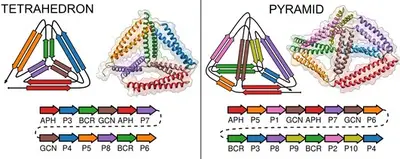Design of in vivo self-assembling coiled-coil protein origami
A Ljubetič*, F Lapenta*, H Gradišar, I Drobnak, J Aupič, Ž Strmšek, D Lainšček, I Hafner-Bratkovič, A Majerle, N Krivec, M Benčina, T Pisanski, TĆ Veličković, A Round, JM Carazo, R Melero, R JeralaNature biotechnology, October 2017; doi: 10.1038/nbt.3994

Proteins are nature’s nano-robots performing key processes necessary for sustaining life. They are built as a linear chain of amino acids which encodes information about the 3D structure and their function. The number of possible sequences is practically infinite: all possible combinations of a 64 amino acid long protein exceed the number of atoms in the known universe. Design of novel proteins is also hampered by extremely complex folding rules.
Researchers at the department of Synthetic biology and immunology have under the guidance of prof. Roman Jerala solved a piece of the protein design puzzle. They have invented a method that enables design of arbitrary protein cages, which self-assemble into the designed shape. The method was named “coiled-coil protein origami” after the Japanese art of paper folding.
Researchers have designed and characterized three types of CC protein cages: a tetrahedron, a square pyramid and a triangular prism. The prism contains more than 700 amino acids and represents the largest artificially designed single chain protein. Researchers have shown that the cages correctly fold in bacteria, mammalian cells and animals, without causing inflammation or other adverse side effects. Using a variety of biophysical and structural techniques including SAXS and electron microscopy (EM), the structure of the cages was shown to agree well with the design models. The sides of the cages are approximately 5 nm in size.
The work “Design of coiled-coil protein origami cages that self-assemble in vitro and in vivo” was published in Nature Biotechnology (http://dx.doi.org/10.1038/nbt.3994). The authors believe that the cages have many potential applications, such as in cargo delivery, enzyme encapsulation, efficient vaccine design, chemical catalysis, design of smart nanomaterials and biosensor construction.
Link CoCoPOD: https://github.com/NIC-SBI/CC_protein_origami
